
Graiguenamanagh or Graignamanagh is a village on the River Barrow in County Kilkenny, Ireland. Part of the settlement, known as Tinnahinch, is on the County Carlow side of the river, and Carlow County Council refers to the whole village as "Graiguenamanagh-Tinnahinch". It is at the foot of Brandon Hill and is home to Duiske Abbey, the largest of the thirty-four mediaeval Cistercian abbeys in Ireland.
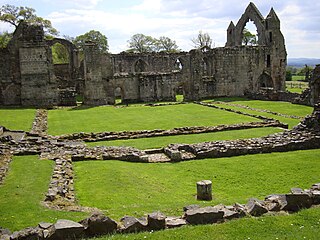
Haughmond Abbey is a ruined, medieval, Augustinian monastery a few miles from Shrewsbury, England. It was probably founded in the early 12th century and was closely associated with the FitzAlan family, who became Earls of Arundel, and some of their wealthier vassals and allies. It was a substantial, successful and wealthy house for most of its four centuries, although evidence of abuses appeared before its dissolution in 1539. The buildings fell into disrepair and the church was largely destroyed, although the remains of some of the domestic buildings remain impressive. The site is now in the care of English Heritage and is open to the public during the summer.
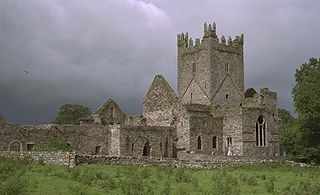
Jerpoint Abbey is a ruined Cistercian abbey, founded in the second half of the 12th century, near Thomastown, County Kilkenny, Ireland. It is located 2.5 km south west from Thomastown on the R448 regional road. There is a Visitor Centre with an exhibition. It has been declared a national monument and has been in the care of the Office of Public Works since 1880.

Boyle Abbey was the first successful foundation in Connacht of the Cistercian order which had opened its first Irish house at Mellifont, County Louth, in 1142.

The Callan Augustinian Friary is an Augustinian friary situated in Callan, Co Kilkenny, Ireland. It is known locally as the "Abbey Meadow" and is located to the north-east of the town, on the banks of the Kings River. The new Augustinian Friary located in the town via the river is connected to the Abbey.

Molana Abbey is a 6th-century Abbey located on the south coast of Ireland in the Diocese of Waterford and Lismore, near Youghal. The abbey lies on an island in the River Blackwater. The monks of the monastery helped co-edit Collectio canonum Hibernensis in the 8th century. It came under the control of the Augustinian canons in the 12th century before being seized by the English Crown during the Reformation and gradually falling into ruin.

Duiske Abbey National Monument, also known as Graiguenamanagh Abbey, is a 13th-century Cistercian monastery situated in Graiguenamanagh, County Kilkenny in Ireland.
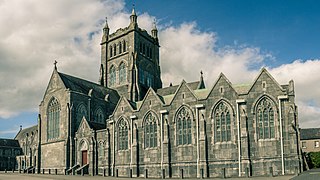
Mount Melleray Abbey is a Trappist monastery in Ireland, founded in 1833. It is situated on the slopes of the Knockmealdown Mountains, near Cappoquin, Diocese of Waterford.

Clare Abbey, also known as Clareabbey, is a ruined Augustinian monastery located near the Town of Ennis, along the banks of the Fergus River, and about a mile north of Clarecastle in County Clare, Ireland. The Abbey, founded in 1189, was the largest and most important of the Augustinian monasteries in County Clare.
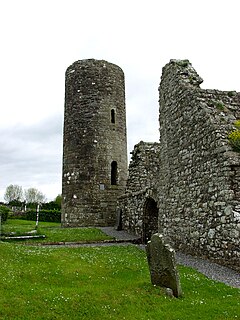
Drumlane is a townland situated near the village of Milltown, area 85.76 hectares, in County Cavan, Ireland. Drumlane is also the name of the civil parish in which the townland is situated. Saint Columba brought Christianity to Drumlane in 555, and Saint Máedóc of Ferns was the patron saint of Drumlane Abbey. Saint Máedóc made the Connachta nobleman Faircheallaigh the first Abbot of Drumlane in the 7th century and his Ó Faircheallaigh descendants were historically the Abbots of Drumlane. The name Drumlane denotes the drumlin region of low hilly ribbed moraines formed over a limestone bedrock created by the movement of glacial ice and melt water during the last ice age. Several townlands in the neighbourhood are prefixed with the word 'Drum', while several others are prefixed with the word 'Derry', which is Irish for oak.

Grangefertagh is a former abbey located in County Kilkenny, Ireland. It is today a National Monument.
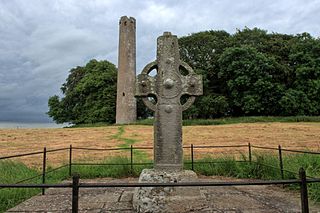
Kilree is a former Christian monastery and National Monument located in County Kilkenny, Ireland.

St. John's Abbey, also called St John's Priory, is a medieval Augustinian abbey and National Monument located in Kilkenny City, Ireland. The Lady Chapel of the Abbey is now used as a parish church of the Church of Ireland.

Inishmaine Abbey is a former Augustinian monastery and National Monument located in County Mayo, Ireland.

The Priory of St. Mary in Cahir, known as Cahir Abbey, was a medieval priory of Augustinian Canons regular and is a National Monument located in Cahir, Ireland.

Monasteranenagh Abbey is a medieval friary and National Monument located in County Limerick, Ireland.

The Priory of Saint Mary, Clontuskert-Hy-Many, also called Clontuskert Abbey, is a medieval Augustinian priory and National Monument located in County Galway, Ireland.

Upperthird or Upper Third is a barony in County Waterford, Republic of Ireland.

Felix Ua Duib Sláin, often anglicised as Felix O'Dullany was a medieval Irish bishop.






















